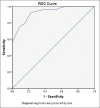Predictors of mortality of severe sepsis among adult patients in the medical Intensive Care Unit
- PMID: 28671163
- PMCID: PMC5504889
- DOI: 10.4103/lungindia.lungindia_54_16
Predictors of mortality of severe sepsis among adult patients in the medical Intensive Care Unit
Abstract
Background: Sepsis is an important cause of mortality in the Intensive Care Units (ICUs) worldwide. Information regarding early predictive factors for mortality and morbidity is limited.
Aims and objectives: The primary objective of the study was to estimate the mortality of severe sepsis among adult patients admitted into the medical ICU. The secondary objective was to identify the predictors associated with mortality.
Materials and methods: Adult patients admitted with severe sepsis in the medical ICU were studied. The primary outcome was the mortality among the study population. Baseline demographic, clinical, and laboratory data were recorded upon inclusion into the study. Risk factors associated with mortality were studied by univariate analysis. The variables having statistical significance were further included in multivariate analysis to identify the independent predictors of mortality.
Results: Out of eighty patients, 54 (67.5%) died. Univariate analysis showed that age >60 years, tachycardia, hypotension, elevated C-reactive protein (CRP) and lactate, thrombocytopenia, need of mechanical ventilation, and high Acute Physiology and Chronic Health Evaluation (APACHE) II and Sequential Organ Failure Assessment scores were variables associated with high mortality. The independent predictors of mortality identified by multivariate regression analysis were platelet count below 1 lakhs, serum levels of CRP >100, APACHE II score >25 on the day of admission to the ICU with severe sepsis, and the need for invasive mechanical ventilation.
Conclusions: Low platelet count, elevated serum levels of CRP, APACHE score >25, and the need for invasive mechanical ventilation were found to be independent predictors of mortality of severe sepsis among adult patients with severe sepsis in the medical ICU.
Conflict of interest statement
There are no conflicts of interest.
Figures
Similar articles
-
[A new warning scoring system establishment for prediction of sepsis in patients with trauma in intensive care unit].Zhonghua Wei Zhong Bing Ji Jiu Yi Xue. 2019 Apr;31(4):422-427. doi: 10.3760/cma.j.issn.2095-4352.2019.04.010. Zhonghua Wei Zhong Bing Ji Jiu Yi Xue. 2019. PMID: 31109414 Chinese.
-
Predictive value of C-reactive protein and NT-pro-BNP levels in sepsis patients older than 75 years: a prospective, observational study.Aging Clin Exp Res. 2020 Mar;32(3):389-397. doi: 10.1007/s40520-019-01244-0. Epub 2019 Jun 18. Aging Clin Exp Res. 2020. PMID: 31214930
-
[Clinical predictive value of short-term dynamic changes in platelet counts for prognosis of sepsis patients in intensive care unit: a retrospective cohort study in adults].Zhonghua Wei Zhong Bing Ji Jiu Yi Xue. 2020 Mar;32(3):301-306. doi: 10.3760/cma.j.cn121430-20190909-00069. Zhonghua Wei Zhong Bing Ji Jiu Yi Xue. 2020. PMID: 32385993 Chinese.
-
[Predictive value of SOFA score combined AGI grading system in elderly patients with sepsis: a retrospective analysis with 91 patients].Zhonghua Wei Zhong Bing Ji Jiu Yi Xue. 2017 Feb;29(2):145-149. doi: 10.3760/cma.j.issn.2095-4352.2017.02.010. Zhonghua Wei Zhong Bing Ji Jiu Yi Xue. 2017. PMID: 28625262 Chinese.
-
Outcomes and prognostic factors in patients with haematological malignancy admitted to a specialist cancer intensive care unit: a 5 yr study.Br J Anaesth. 2012 Mar;108(3):452-9. doi: 10.1093/bja/aer449. Epub 2012 Jan 31. Br J Anaesth. 2012. PMID: 22298243 Review.
Cited by
-
Thrombo-inflammatory biomarkers to predict sepsis outcome.Int J Immunopathol Pharmacol. 2021 Jan-Dec;35:20587384211048561. doi: 10.1177/20587384211048561. Int J Immunopathol Pharmacol. 2021. PMID: 34647483 Free PMC article.
-
Neutrophil CD64-a prognostic marker of sepsis in intensive care unit: a prospective cohort study.Front Med (Lausanne). 2023 Sep 8;10:1251221. doi: 10.3389/fmed.2023.1251221. eCollection 2023. Front Med (Lausanne). 2023. PMID: 37746077 Free PMC article.
-
Mean arterial pressure and mortality in patients with distributive shock: a retrospective analysis of the MIMIC-III database.Ann Intensive Care. 2018 Nov 8;8(1):107. doi: 10.1186/s13613-018-0448-9. Ann Intensive Care. 2018. PMID: 30411243 Free PMC article.
-
Systemic inflammatory response syndrome criteria (SIRS) and sepsis 3 criteria for assessing outcomes in sepsis: A prospective observational study.Lung India. 2023 May-Jun;40(3):200-204. doi: 10.4103/lungindia.lungindia_400_22. Lung India. 2023. PMID: 37148015 Free PMC article.
-
Hierarchical Capability in Distinguishing Severities of Sepsis via Serum Lactate: A Network Meta-Analysis.Biomedicines. 2024 Feb 17;12(2):447. doi: 10.3390/biomedicines12020447. Biomedicines. 2024. PMID: 38398049 Free PMC article. Review.
References
-
- Marshall JC, Vincent JL, Guyatt G, Angus DC, Abraham E, Bernard G, et al. Outcome measures for clinical research in sepsis: A report of the 2nd Cambridge Colloquium of the International Sepsis Forum. Crit Care Med. 2005;33:1708–16. - PubMed
-
- Engel C, Brunkhorst FM, Bone HG, Brunkhorst R, Gerlach H, Grond S, et al. Epidemiology of sepsis in Germany: Results from a national prospective multicenter study. Intensive Care Med. 2007;33:606–18. - PubMed
-
- Boechat Tde O, Silveira MF, Faviere W, Macedo GL. Thrombocitopenia in sepsis: An important prognosis factor. Rev Bras Ter Intensiva. 2012;24:35–42. - PubMed
LinkOut - more resources
Full Text Sources
Other Literature Sources
Research Materials
Miscellaneous





